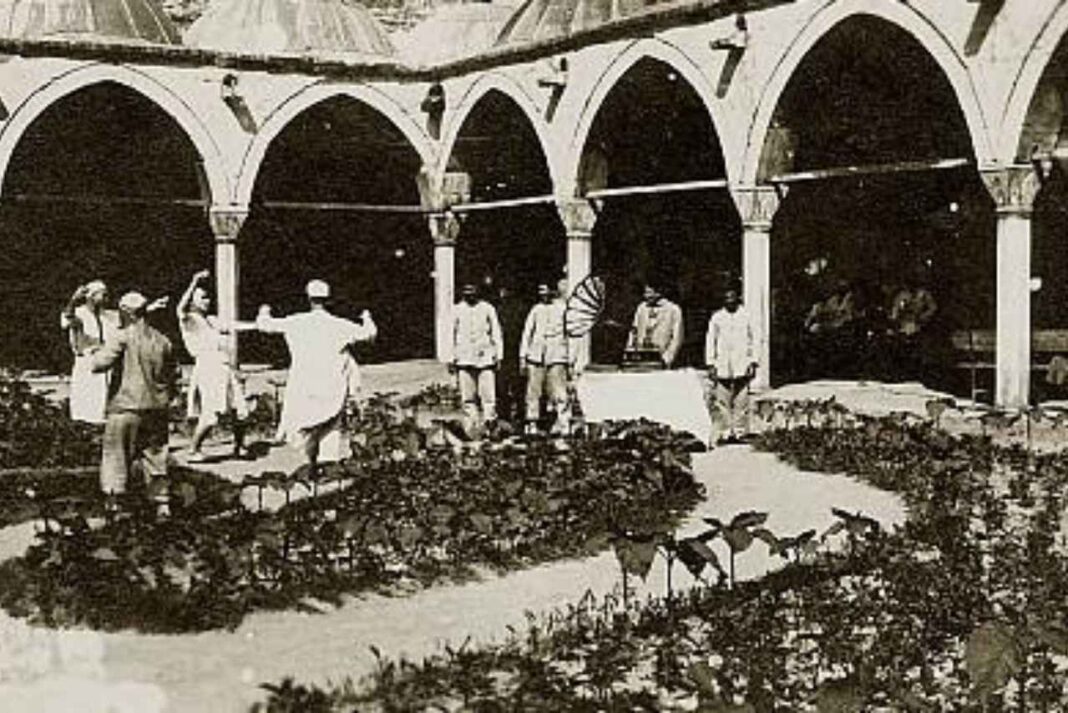Mental and psychological well-being has been one of the most important issues throughout human history. In the Middle Ages, particularly in European countries, individuals with mental disorders were subjected to stigmatization such as being labeled as “possessed,” “witches,” or “demonic,” and were often imprisoned, isolated, or subjected to violence, sometimes even leading to death. This situation began to change with the Renaissance, initiating a process that evolved into today’s modern mental health practices.
When examining mental health institutions and practices in Turkey, it is essential to consider the concept of bimarhane. In the Ottoman Empire, bimarhanes functioned as healing centers where individuals with mental illnesses were treated and rehabilitated for reintegration into society. The most comprehensive regulation governing these institutions, the nizamname, was enacted in December 1913. The mental health institutions known as bimarhanes during the Ottoman era were later renamed “Hospitals for Mental and Neurological Diseases” (Emraz-ı akliye ve asabiye hastanesi) during the Republican period.
When examining the physical structure of the bimarhanes, one finds a courtyard with a dome and a central pool, along with rooms arranged for summer and winter accommodations. Opposite the entrance was a room specifically designed for music therapy. It is understood that the buildings were constructed with architectural and acoustic considerations necessary for musical treatment (Emlak Encyclopedia, 2013). One of the most prominent and well-known bimarhanes was the Toptaşı Bimarhane, founded in 1582 by Nurbanu Sultan, the mother of Sultan Murad III.
Treatment Methods in Bimarhanes
According to the majority of medical historians, the treatment of individuals with mental illnesses and the societal perspective towards these conditions in the Turkish-Islamic states were far more humane and advanced than those of their European counterparts at the time. Evliya Çelebi, in his travels throughout the territories of the Ottoman Empire, provided many accounts supporting this comparison. In his Seyahatname (Book of Travels), he mentioned bimarhanes located in cities such as Damascus, Cairo, and Edirne (Yiğitbaş, 1972).
The use of music and rhythm as a therapeutic method existed in Turkish societies both before and after the advent of Islam. The most scientifically appropriate utilization of music and rhythm is seen during the Seljuk and Ottoman periods. The architectural design of medical facilities in these periods incorporated acoustic features to support such therapies (Akdeniz, 1977; Atıcı & Erer, 2010). It is known that music and rhythm had particularly positive effects on patients who were melancholic, withdrawn, or emotionally fragile (Grebene, 1978).
Evliya Çelebi described several notable aspects of the bimarhanes, including architectural elements that supported therapeutic environments (e.g., pools in gardens, water sounds, acoustics for music), and the management of patients, some of whom would roar, speak to themselves, or be restrained with chains to prevent harm to others. During his visit to a bimarhane in Damascus, he observed that physicians administered special medicinal pastes to certain patients (Ertaş & Eğnim, 2011). The use of pleasant scents was also emphasized, as physicians believed elements such as water sounds, music, and fragrance positively influenced general mental well-being. Overall, anything that contributed to a person’s sense of wellness was employed as a form of treatment.
Conclusion
Bimarhanes, which emerged in Islamic geography, reached their most comprehensive and effective forms under the Seljuk and Ottoman Empires. It is believed that the first bimarhane in the Islamic world was established during the Battle of the Trench, one of the earliest battles in Islamic history (Sarı & Zabun, 2021). The Ottoman Empire advanced the bimarhane model inherited from the Seljuk Empire. These institutions did not only serve individuals with mental disorders, but also provided shelter and care for the poor and travelers in need. Reflecting the economic conditions of the empire, most services in bimarhanes were offered free of charge, typically funded by charitable foundations (waqfs). The transformation of the term bimarhane to tımarhane in popular language became more common after the 17th century.
Generally, inpatient care was the norm in bimarhanes, where patients were accommodated in seasonal rooms (summer and winter), relaxed by the sounds of water near pools, listened to music, and were exposed to pleasant scents to encourage socialization. As with all diseases, nutrition was considered critical for mental health, and balanced diets were provided. A musical ensemble would visit the bimarhane approximately three times a week, performing concerts with instruments such as the oud, ney, and violin. While individuals with mental illnesses were often tortured and demonized in European societies during this period, the techniques used in Ottoman bimarhanes were significantly ahead of their time. In conclusion, many of the methods employed in bimarhanes can be seen as precursors to, and foundational for, today’s scientifically recognized psychiatric techniques.
References
-
http://emlakansiklopedisi.com/wiki/bimarhane-nedir; 2013. Retrieved: May, 2020
-
Yiğitbaş, M.S. (1972). Musiki İle Tedavi. www.emlakansiklopedisi.com. (2013, November 26).
-
Akdeniz, N. (1977). Osmanlılarda Hekim ve Deontolojisi. Istanbul: Istanbul University Cerrahpaşa Faculty of Medicine Publications.
-
Ertaş, M. Y., Eğnim, K. (2011). Evliya Çelebi Seyahatnamesinde Hastalıklar. Pamukkale University Journal of Social Sciences Institute, (10), 83–108.
-
Grebene, B. (1978). (Ed). Müzikle Tedavi. Ankara: Güven Kitabevi.
-
Sarı, A., & Zabun, S. (2021). BİMARHANELER HAKKINDA ALAN YAZIN ÇALIŞMASI. International Journal of Health Management and Strategies Research, 7(3), 585–599.



